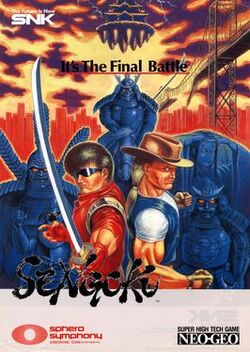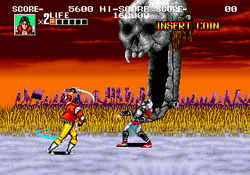Software:Sengoku (1991 video game)
| Sengoku | |
|---|---|
 | |
| Developer(s) | SNK |
| Publisher(s) | SNK
|
| Composer(s) | Toshio Shimizu Yasuo Yamate |
| Series | Sengoku |
| Platform(s) |
|
| Release | |
| Genre(s) | Beat 'em up, hack and slash |
| Mode(s) | |
| Arcade system | Neo Geo MVS |
Sengoku[lower-alpha 1] is a beat 'em up arcade game. It is the first entry of the Sengoku trilogy by SNK. It was ported to numerous home consoles including the Neo Geo,[1] Neo Geo CD,[2] Mega-CD and Super Famicom. The arcade version was part of SNK Arcade Classics Vol. 1, released in 2008. The Neo Geo version was re-released on the Japanese Virtual Console in 2011, with the sequels for the North American Virtual Console on November 8, 2012 (Sengoku 2) and June 6, 2013 (Sengoku 3) and for the PAL region on February 7, 2013 (Sengoku 2) and September 5, 2013 (Sengoku 3). In 2009 the series was compiled on the Sengoku Anthology for PlayStation 2 and Windows.
Gameplay
A player has a maximum of six health points. When certain enemies are defeated, spirits of powerful forms are available to transform into. In the SNES version transformation cannot be toggled, but stays constant for a limited time. The three different forms are a samurai, an armour-clad wolf and a more agile ninja. These forms have a limited use. Their attacks and jumps differ from the original form and their powers are enhanced by any power-ups collected.
Throughout the game the player would need to survive the hordes of enemies by collecting coloured orbs as power-ups. Ten Green orbs heal one health point. A Red orb gives the player a single sword, a Cyan orb gives the player a dual swords, the Purple orb gives the player a two-handed holy sword and a Yellow orb gives the player a limited magical attack.
Plot
Centuries ago a cruel and insanely tyrannical warlord was defeated by the two elite Samurai but had sworn to return in the future. When he does he unleashes undead forces of feudal Japanese warriors to destroy the world and its people. The warlord is opposed only by the two protagonists, a ninja and a Western cowboy (named Ninja Dave and Cowboy Kev in the Neo-Geo version[3] and named Dan and Bill in the SNES version), who turn out to be descendants of the two elite Samurai responsible for vanquishing the wicked warlord centuries ago.
Reception
| Sengoku | ||||||||||
|---|---|---|---|---|---|---|---|---|---|---|
| ||||||||||
In Japan, Game Machine listed Sengoku on their March 15, 1991 issue as being the thirteenth most-successful table arcade unit of the month.[6] Likewise, RePlay reported Sengoku to be the fourth most-popular arcade game at the time.[7]
On release, Famicom Tsūshin scored the Neo Geo version of the game a 19 out of 40.[8] Electronic Gaming Monthly gave the Super NES version a 4.4 out of 10, commenting that it "has an interesting concept as you can change into different types of fighters, yet it just doesn't come together."[4] Power Unlimited gave the Neo Geo version a score of 85% writing: "A top-shelf brawler, even for people who aren't much of a fighter. The game gives you a real fighting feeling, thanks to the great sounds and images."[9]
Notes
References
- ↑ "Oh! Neo Geo Vol. 9 - 戦国伝承". Beep! Mega Drive (SoftBank Creative) (44): 142. May 1993. https://retrocdn.net/index.php?title=File%3ABeepMD_JP_1993-05.pdf&page=144.
- ↑ "Neo•Geo CD: The Arcade In A Box - Sengoku". GamePro (IDG) (Premiere Supplement): 106. Spring 1996. https://archive.org/stream/GamePro_The_Cutting_Edge_Spring_1996#page/n111/mode/2up.
- ↑ 3.0 3.1 Computer & Video Games, January '92. Computer & Video Games. January 1992. p. 38. https://archive.org/stream/Computer_Video_Games_Issue_122_1992-01_EMAP_Publishing_GB/Computer__Video_Games_Issue_122_1992-01_EMAP_Publishing_GB#page/n37. Retrieved 21 July 2017.
- ↑ 4.0 4.1 "Review Crew: Sengoku". Electronic Gaming Monthly (Sendai Publishing) (56): 34. March 1994.
- ↑ "Power Unlimited Game Database" (in nl). November 1994. Archived from the original on October 22, 2003. https://web.archive.org/web/20031022173402/http://www.powerweb.nl:80/database/img/index.php?page=database&&query%5border%5d=datum&ending=DESC&query%5bstart%5d=4000. Retrieved November 22, 2022.
- ↑ "Game Machine's Best Hit Games 25 - テーブル型TVゲーム機 (Table Videos)". Game Machine (Amusement Press, Inc.) (399): 25. 15 March 1991.
- ↑ "The Player's Choice - Top Games Now in Operation, Based on Earnings-Opinion Poll of Operators: Best Software". RePlay (RePlay Publishing, Inc.) 16 (7): 4. April 1991.
- ↑ NEO GEO GAMES CROSS REVIEW: 戦国伝承. Weekly Famicom Tsūshin. No.332. Pg.25. 28 April 1995.
- ↑ "Power Unlimited Game Database" (in nl). November 1994. Archived from the original on October 22, 2003. https://web.archive.org/web/20031022173402/http://www.powerweb.nl:80/database/img/index.php?page=database&&query%5border%5d=datum&ending=DESC&query%5bstart%5d=4000. Retrieved November 22, 2022.
External links
- Sengoku at GameFAQs
- Sengoku at Giant Bomb
- Sengoku at the Killer List of Videogames
- Sengoku at MobyGames
 |


